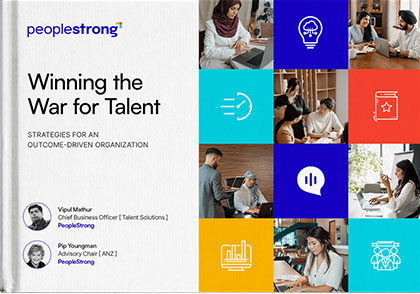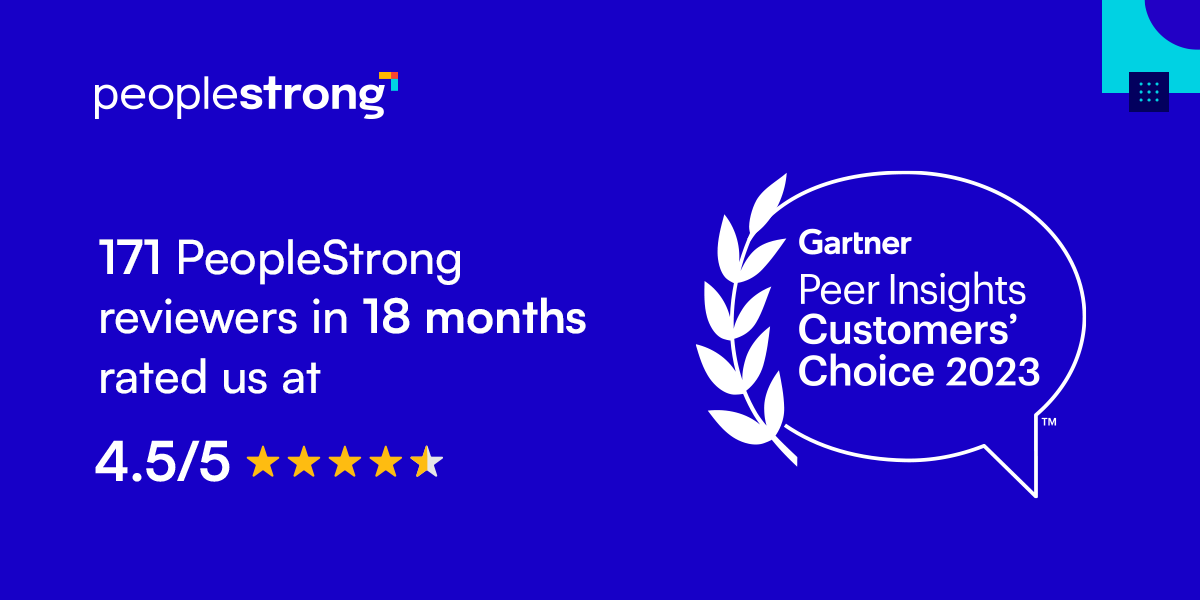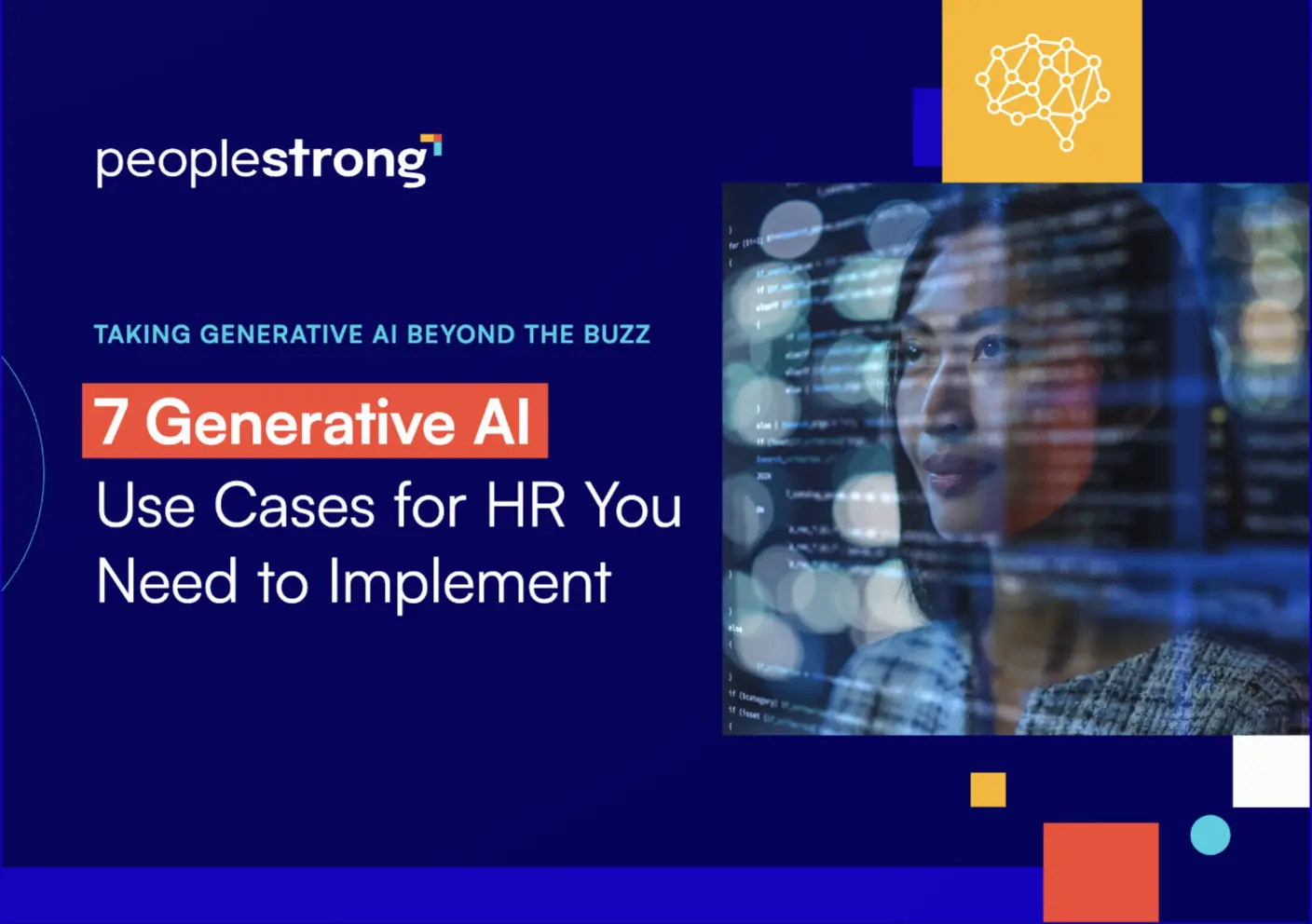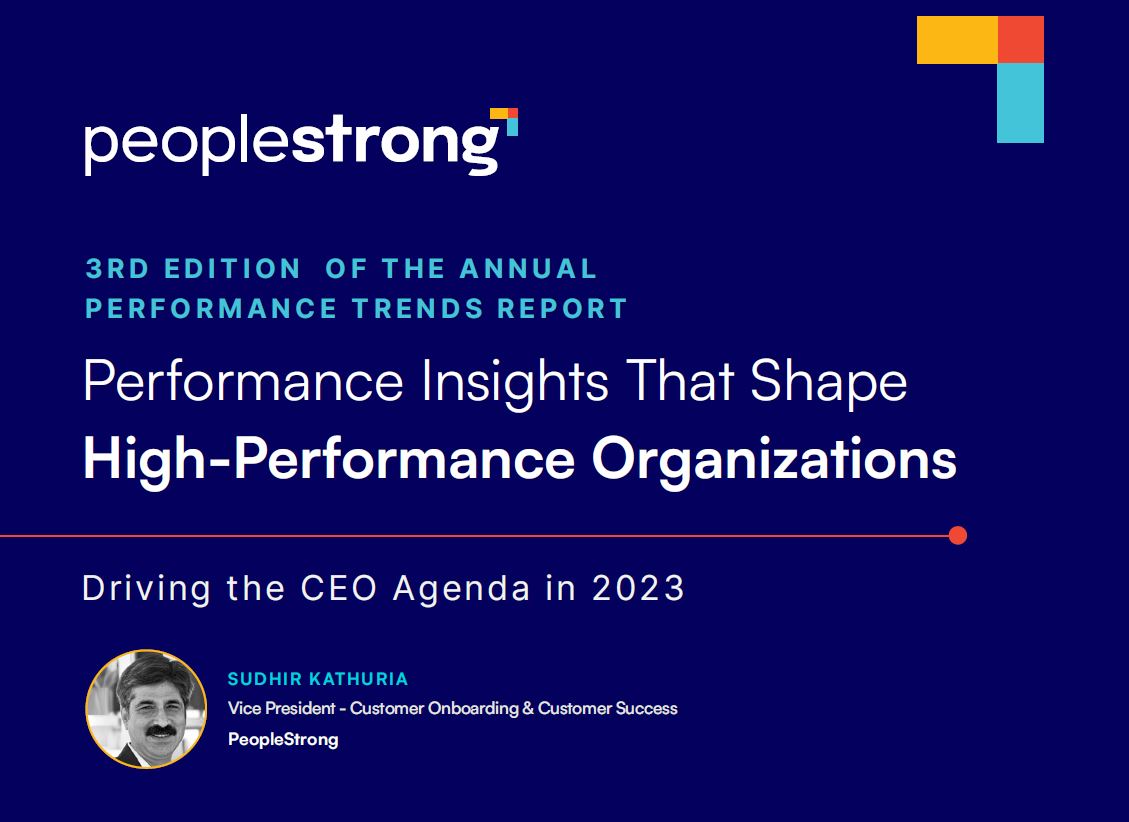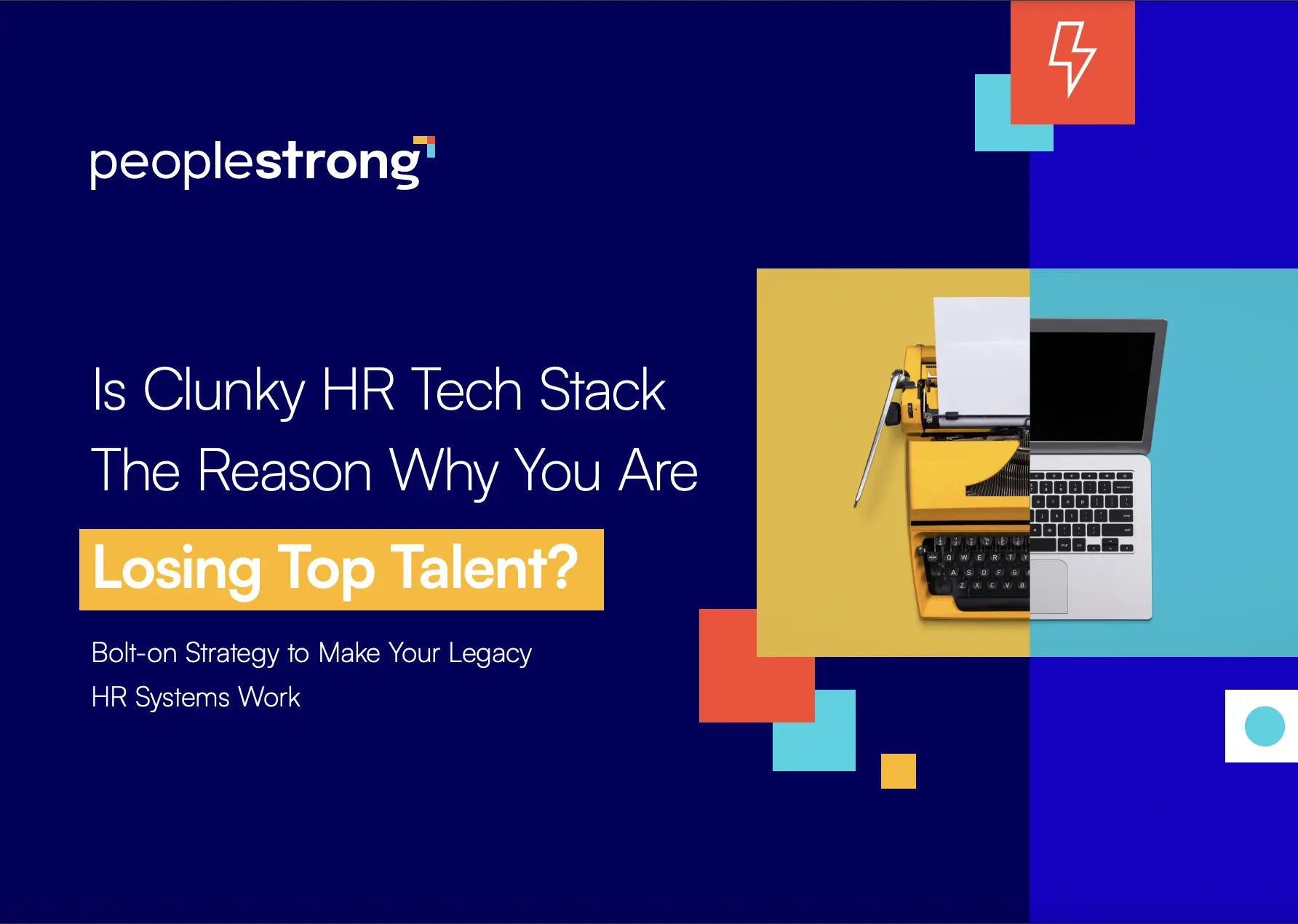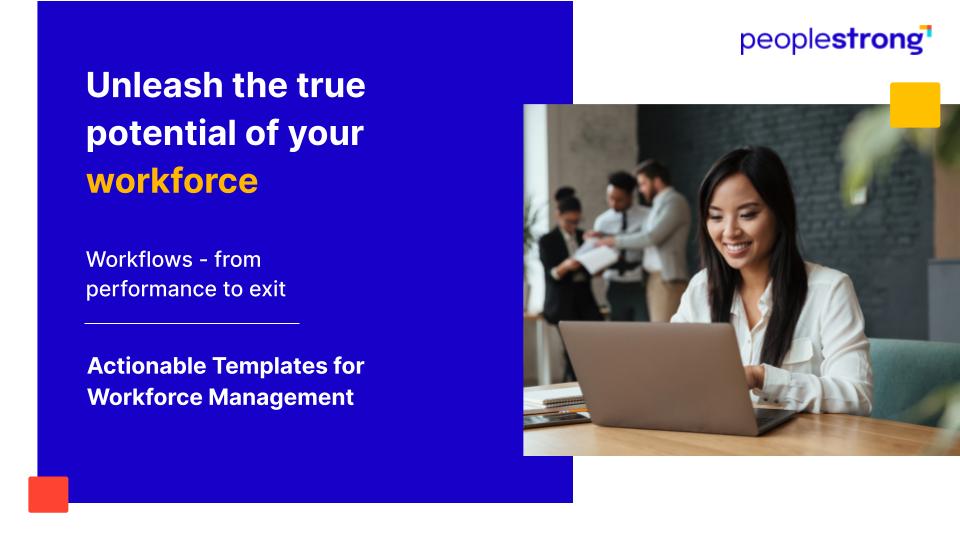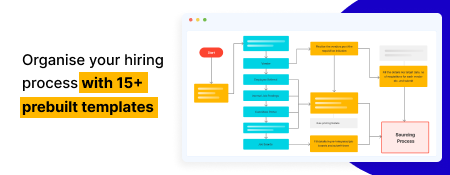How to Develop an Effective HR Strategy in 2024

Win the war for talent, without an army of recruiters.
Accurate, compliant, and automated workflows — from punch to payroll.
A comprehensive HR tech suite to help you leverage data, processes, and insights to create seamless employee experiences.
Hire smarter, to hire the best
OnboardingMake their first experience a delight
Core HRTake control of your people strategy
PayrollRoll the pay, with 100% confidence
Payroll ServicePayroll outsourcing you can
rely on
Punch-in to modern workforce management
Performance Powered by AIBuilding efficient performance culture
Learning Powered by AIBuilding capabilities for agility
Career & Skills Powered by AIIdentify skill gaps & execute talent programs
Succession PlanningBuild robust talent pipeline for critical positions
CompensationFacilitate growth with the right compensation
AnalyticsTurn HR data into actionable insights
CollaborationUnite across teams, departments & time zones
Unleash the true potential of your workforce to drive agility and growth.
Hire smarter, to hire the best
OnboardingMake their first experience a delight
Performance Powered by AIBuilding efficient performance culture
Facilitate growth with the right compensation
Building capabilities for agility
Career & Skills Powered by AIIdentify skill gaps & execute talent programs
Succession PlanningBuild robust talent pipeline for critical positions
Create custom reports to analyze workforce data
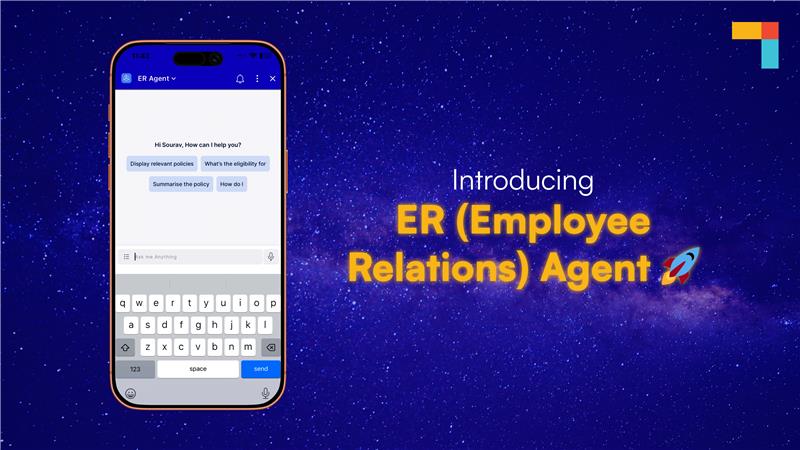

How top enterprises drive impact with PeopleStrong
Fast, secure, and scalable deployments
Expert assistance to keep you moving





According to Gartner, 46% of HR leaders reported that recruiting is their top priority. However, despite this emphasis, 36% of HR leaders say they lack the necessary resources to recruit top talent effectively.
This disconnect underscores the need for a comprehensive HR strategy for organizations striving to attract and retain skilled employees.
Recruitment challenges are just the tip of the iceberg. Another critical issue is employee retention.
Alarmingly, 30% of new hires leave within the first 90 days, leading to significant disruptions and increased costs (Source: HBR).
Given these challenges, a well-defined HR strategy is essential for aligning your workforce with your organizational goals, enhancing employee engagement, and driving long-term growth.
An effective HR strategy serves as a roadmap for managing an organization’s most valuable asset—its people. It encompasses everything from workforce planning and talent acquisition to performance management and employee engagement. By aligning HR initiatives with the overall business strategy, organizations can enhance productivity, foster innovation, and create a positive work environment.
In this blog we will discuss how to create an HR strategy that supports business objectives while cultivating a resilient and agile workforce. We’ll also go through the HR strategy framework and give you real life examples of successful HR strategy.
An HR strategy is a comprehensive plan that outlines how a company will manage and develop its workforce to align with its business goals. It involves systematic planning to ensure that the organization has the right people in place, with the right skills, at the right time.
This strategy serves as a roadmap for all HR-related activities, guiding the organization in areas such as recruitment, training, performance management, and employee retention.
Suggested Read:
Complete Guide to Employee Retention in a Volatile Labor Market
HR leaders are stepping up and taking on a more prominent role in driving midsize business success. Their role extends beyond traditional workforce improvement metrics to encompass the implementation of innovative strategies and technology investments that spur rapid and sustained growth.
In growth-focused companies, HR priorities are translating into significant opportunities. According to a recent IDC analyst brief, the adoption of appropriate technologies is instrumental for midsize organizations to thrive.
Key benefits include:
Despite these advantages, not all midsize companies are prepared to modernize their processes comprehensively. HR leaders can navigate this challenge by identifying and addressing their organization’s most pressing pain points. By developing a strategic plan that empowers employees and promotes sustainable growth, HR can facilitate the transition towards modernization.
Ultimately, the proactive involvement of HR in technology adoption and strategic planning is crucial for midsize businesses aiming for long-term success and competitiveness in an evolving market landscape.
For HR professionals, understanding and implementing key modules of an effective HR strategy can drive organizational success and foster a thriving workforce. Let’s delve into the critical areas that form the backbone of a robust HR strategy.
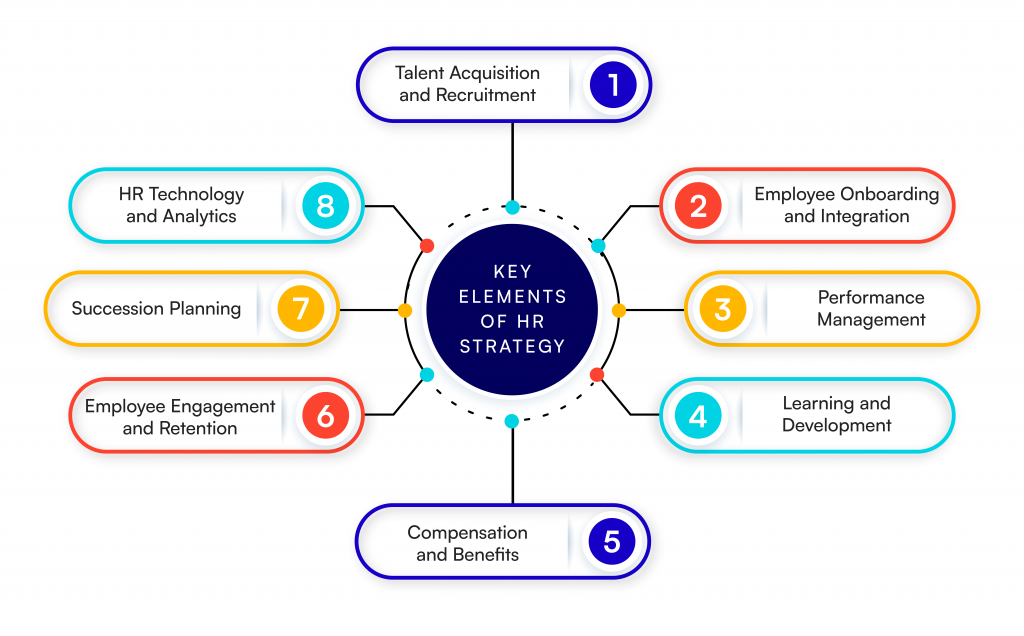
Talent acquisition is the first step in building a capable workforce. This module focuses on attracting, sourcing, and selecting candidates who not only possess the required skills but also align with the company’s culture and values.
Suggested Read:
The Ultimate Recruitment Process Guide
Once the right talent is acquired, effective onboarding ensures new hires are integrated smoothly into the organization. This module covers:
Performance management is crucial for maintaining high productivity and ensuring employees’ contributions align with business goals.
Continuous learning and development are vital for employee growth and organizational success. This module includes:
A competitive compensation and benefits strategy is essential for attracting and retaining top talent.
Engaged employees are more productive and less likely to leave the organization. This module focuses on:
Preparing for future leadership needs is crucial for long-term success.
Leveraging technology and data analytics can enhance the efficiency and effectiveness of HR functions.
Here is our step by step HR strategy framework to align your HR initiatives with your business goals, attract top talent, and foster a productive workplace.
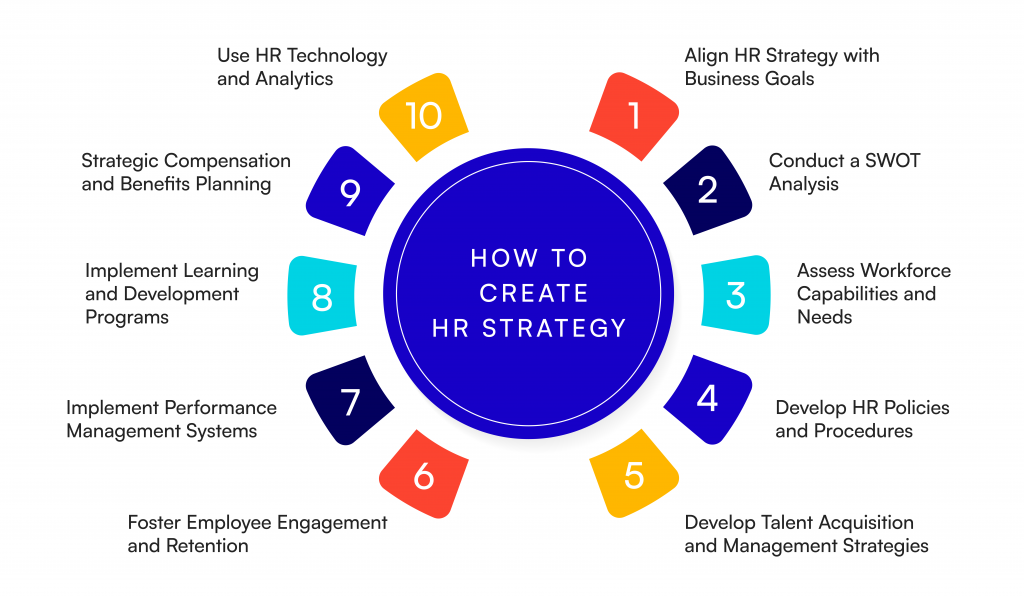
The first step in creating an HR strategy is to ensure it aligns with the overall business goals. Understand the organization’s vision, mission, and strategic objectives. Engage with senior leadership to gain insights into business priorities and challenges. This alignment ensures that HR initiatives directly contribute to achieving business outcomes, fostering a unified direction across the organization.
Perform a SWOT (Strengths, Weaknesses, Opportunities, Threats) analysis to assess the current state of your HR department. Identify internal strengths and weaknesses in HR processes, talent, and capabilities.
Evaluate external opportunities and threats such as market trends, competition, and regulatory changes. This analysis provides a clear picture of where your HR stands and where improvements are needed.
Here is an example of HR SWOT Analysis:
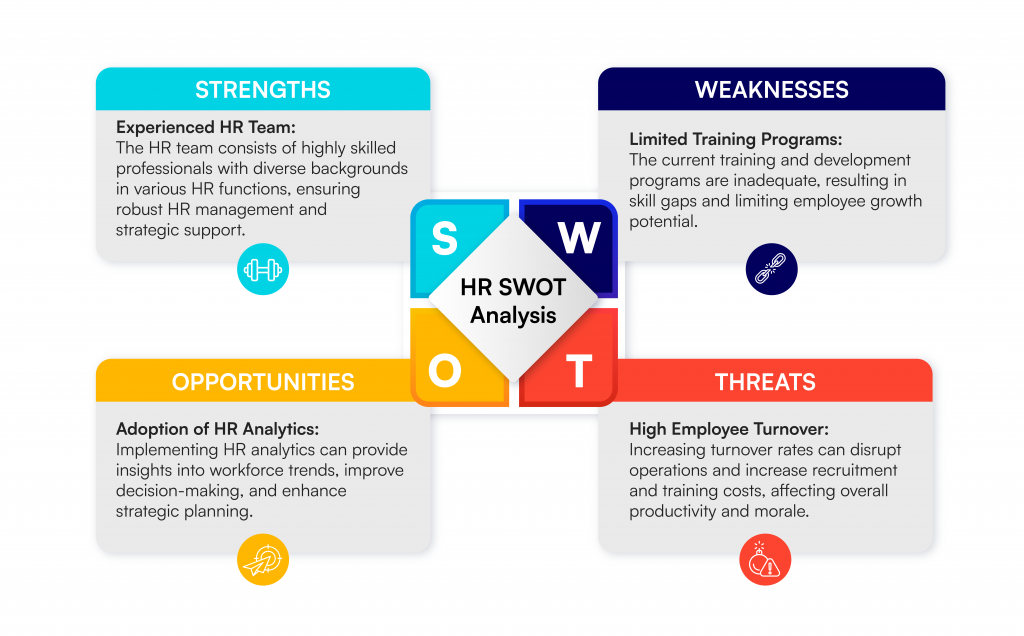
Evaluate the current workforce’s skills, competencies, and capabilities to identify gaps and future needs. Conduct a thorough analysis of the existing talent pool, considering factors such as skill sets, experience, and potential for growth.
Engage with department heads and managers to understand their specific talent needs and challenges. This assessment will inform your HR strategy by highlighting areas where additional training, hiring, or restructuring may be necessary to meet business goals.
Establish comprehensive HR policies and procedures that support your HR objectives and align with legal requirements. Policies should cover areas such as recruitment, onboarding, performance appraisal, disciplinary actions, and employee benefits. Well-defined policies ensure consistency, fairness, and legal compliance across the organization.
Design talent acquisition and management strategies to attract, retain, and develop top talent. Implement effective recruitment processes, employer branding initiatives, and succession planning. Develop career paths and growth opportunities to retain high-potential employees and reduce turnover. Talent management is crucial for building a capable and motivated workforce.
Additionally, focus on retention strategies to keep your best employees engaged and committed to the organization. This could include offering career development opportunities, competitive compensation, and a positive work environment.
Using effective onboarding software should introduce new employees to the company culture, provide necessary training, and support their integration into the team.
Create a culture that fosters employee engagement and retention. Implement initiatives such as regular feedback, recognition programs, and work-life balance policies. Encourage open communication and provide opportunities for employees to voice their opinions and suggestions. Engaged employees are more productive, committed, and likely to stay with the organization.
High turnover rates can be costly and disruptive. Develop retention strategies that address the reasons employees leave and enhance their overall job satisfaction. This might include offering competitive salaries and benefits, providing opportunities for career growth, and creating a supportive and inclusive work culture.
Implementing a robust performance management system is essential for aligning employee performance with organizational objectives. Start by defining clear performance metrics and expectations that are directly linked to the company’s strategic goals.
Conduct regular performance reviews to monitor progress, identify areas for improvement, and celebrate achievements. Establish a structured process for delivering constructive feedback and setting development goals. Train managers to provide feedback effectively and support employee growth through targeted training, mentorship, and career development programs.
A well-implemented performance management system cultivates a culture of continuous improvement, accountability, and motivation, ultimately driving organizational success.
SurveyMonkey discovered that approximately 86% of employees consider job training important, and nearly 74% are willing to learn new skills outside of work hours to enhance their job performance.
Invest in learning and development programs to enhance employees’ skills and competencies. Offer a mix of training methods such as workshops, e-learning, mentorship, and on-the-job training. Focus on both technical skills and soft skills development. Continuous learning opportunities help employees stay relevant and contribute to the organization’s success.
A survey conducted by the Society for Human Resource Management (SHRM) found that 92% of employees view benefits as a crucial element of their overall job satisfaction. Additionally, companies offering innovative and comprehensive benefits packages experience a 25% boost in employee loyalty and retention.
Develop competitive compensation and benefits strategy that attract and retain top talent. Conduct market research to ensure your offerings are competitive within your industry. Include components such as base salary, bonuses, health benefits, retirement plans, and other perks. Transparent and fair compensation practices are key to employee satisfaction and retention.
A comprehensive benefits package goes beyond salary to include health insurance, retirement plans, paid time off, and other perks that meet the diverse needs of your workforce.
✅ Tip: Survey your employees to understand their preferences and tailor your benefits offerings accordingly. Flexible working arrangements, wellness programs, and professional development opportunities are increasingly valued by employees and can enhance job satisfaction and loyalty.
Leveraging HR technology and analytics can transform HR practices by providing actionable insights and streamlining processes. Implementing advanced HR software, such as Human Resource Information Systems (HRIS) and talent management platforms, allows for centralized data management and automation of routine tasks.
HR data analytics tools can uncover patterns in employee performance, engagement, and turnover, helping to identify areas for improvement and predict future trends. For example, predictive analytics can forecast employee attrition, enabling proactive retention strategies. Utilizing these technologies not only improves efficiency but also enhances decision-making, ensuring HR strategies are closely aligned with business objectives and responsive to workforce needs.
To provide a clearer understanding of how to develop an effective HR strategy, let’s explore a few real-world HR strategy examples from organizations that have successfully implemented strategic HR initiatives.
Google is renowned for its innovative HR practices and commitment to creating a supportive and engaging workplace.
Google’s HR strategy focuses heavily on talent management and employee satisfaction.
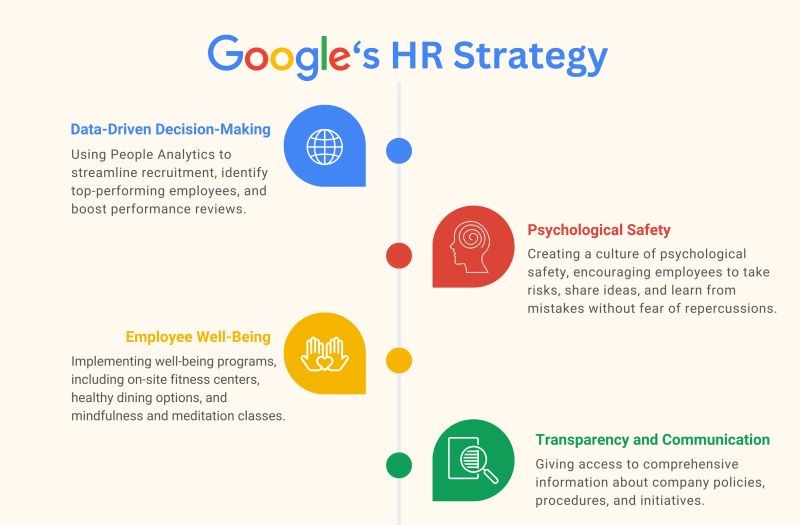
Key initiatives include:
Outcome: Google’s strategic approach to HR has resulted in high employee satisfaction, low turnover rates, and a reputation as one of the best companies to work for.
Starbucks is known for its strong emphasis on employee development and creating a positive work environment.
Starbucks’ HR strategy centers on continuous learning and development, as well as fostering a supportive company culture.
Key initiatives include:
Outcome: Starbucks’ commitment to employee development and inclusive culture has led to high employee loyalty, strong customer service, and overall business success.
HDFC ERGO, faced challenges in managing its growing workforce of over 11,000 professionals across 225 branches, particularly in tier-four and tier-five towns. The HR team sought a technology-driven solution to unify HR practices and provide a seamless employee experience.
HDFC ERGO partnered with PeopleStrong to develop a robust HR Super App. This app integrated key HR functions such as attendance, leaves, approvals, geo-tagging, recruitment, and performance management. It offered a secure, mobile-first experience with enterprise-grade security and scalable architecture, simplifying operations with single sign-on and easy integration of additional features.
Impact:
This collaboration effectively addressed the challenges of managing a diverse and expanding workforce, highlighting the importance of leveraging technology to enhance HR practices and drive organizational efficiency.
A strong HR strategy is essential for driving organizational success and fostering a positive work environment. By investing in strategic HR planning, you can ensure that your workforce is aligned with your business objectives, engaged, and equipped to meet future challenges.
While challenges like aligning HR with business objectives and managing change are inevitable, leveraging HR technology can streamline implementation and provide valuable insights.
Now is the time to take action and start developing your HR strategy. Begin by assessing your current HR practices and identifying areas for improvement. If you need further assistance, feel free to contact us for expert guidance and support.
How can an HR strategy be aligned with business goals?
Aligning an HR strategy with business goals involves understanding the organization’s objectives and ensuring that HR initiatives support these goals. This can be achieved through regular communication with senior leadership, setting aligned HR objectives, and continuously reviewing and adjusting the strategy based on business needs.
What are the common challenges in developing an HR strategy?
Common challenges in developing an HR strategy include aligning HR initiatives with business goals, managing change, ensuring compliance with labor laws, attracting and retaining top talent, and fostering employee engagement. Overcoming these challenges requires a strategic approach, effective communication, and continuous monitoring and adjustment.
How can HR technology aid in implementing an HR strategy?
HR technology, like integrated systems such as PeopleStrong, comprehensively aids in implementing an HR strategy by streamlining processes, enhancing data accuracy, and offering valuable insights through advanced analytics. Tools such as HRIS, ATS, and LMS ensure efficiency, support strategic decision-making, and maintain compliance with regulations, providing a unified solution for all HR needs.
Most organizations and HR professionals focus their attention on inculcating strong values and work ethics...
Hiring discrimination is a common challenge that prevails in the corporate world. Whether it’s based...
Do you remember the last time your organization had to redesign or change its overall...
Enterprises
Countries
Users
Gartner's voice of customer report 2022-2024
Product Stack


Enterprises
Countries
Users
Gartner's voice of customer report 2022-2024
Enterprises
Countries
Users
Gartner's voice of customer report 2022-2024
Enterprises
Countries
Users
Gartner's voice of customer report 2022-2024
Enterprises
Countries
Users
Gartner's voice of customer report 2022-2024
Enterprises
Countries
Users
Gartner's voice of customer report 2022-2024
Enterprises
Countries
Users
Customers' Choice in 2023 Gartner Peer Insights 'Voice of the Customer' Report


